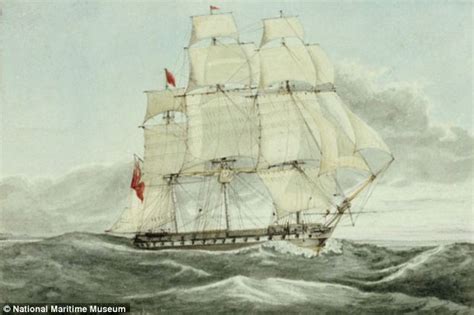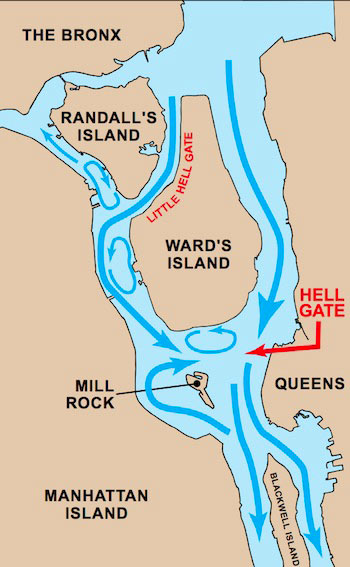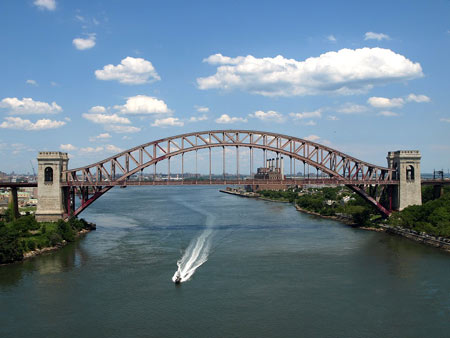Is HMS Hussar’s ‘Treasure’ in a Landfill?

Painting depicts the 28-gun HMS Hussar under full sail.
How many times have we come upon the word “purported” when perusing or researching stories about sunken or buried treasures? The Merriam-Webster Dictionary defines “purport” as: “to imply, profess or claim, often falsely.” I would like to add “supposed to be” to the mix as a further warning that some of the epistles we come upon could be, as Webster says, “false.” They might even be legends, such as the chronicle of the HMS Hussar.
During the American Revolution, the 28-gun Royal Navy frigate HMS Hussar sailed as a “dispatcher” on what the navy called its North American Station. By July, 1779, the British positions around New York became vulnerable when the French army joined forces with General George Washington’s troops north of the city. Just before British Admiral George Bridges Rodney took his fleet of 20 ships south toward Virginia in November, he ordered a destination change on what was purported to be the delivery of general provisions and the English troops’ payroll. The admiral ordered the “dispatcher” to set sail for Gardiner’s Bay where an island outpost at the eastern end of Long Island Sound was used to stock wartime supplies.
On November 24, 1779, Capt. Charles Pole decided to take the HMS Hussar on a shorter, faster route to Gardiner’s Bay. Despite his pilot’s repeated warnings, Pole stuck with his plan to sail from New York’s East River through the risky waters of Hell Gate, a narrow channel that lies between Manhattan and Long Island. Shortly before reaching Long Island Sound, strong winds and tides drove the vessel onto Pot Rock, one of many obstructions impeding ships sailing the passage between the Atlantic Ocean and New York City. Leaking profusely, the 124-foot ship sank in 90 feet of water as the captain and crew manned long boats and made it to the mainland.

Map shows the narrow strait of Hell Gate, East River, New York, Credit: U.S. Army Corps of Engineers
Various accounts of the tragedy emerged, but the British immediately denied that any payroll of gold guineas or sterling silver was consigned on the voyage. Yet, reports spread that $2 to $4 million worth was aboard ship. The survivors never mentioned a valuable cargo, nor was there any listed on the cargo manifest. The Brits offered many denials of the payroll delivery, but were suspect when they conducted extensive salvage efforts. They salvaged some cannons and ship’s fittings, but records revealed nothing about specie (what they called coins). The wreck was dynamited when salvage was over.
In 1876, the U. S. Army Corps of Engineers used 25 tons of explosives that “blew the harrowing aspects of the Hell Gate’s rocky bottom right back to hell.” In spite of all this destruction, salvage efforts continued throughout the years. In the 1930s, submarine pioneer Simon Lake spent years and much of his fortune vainly searching for the wreck. In 2013, after Hurricane Sandy hit the East Coast, recollections of the HMS Hussar surfaced (pun intended). Perhaps the violent storm had churned the waterway enough to wash remnants of the ship ashore. New Yorker Steve Smith, walking the South Bronx shoreline after the storm, discovered wooden planks from a very old shipwreck. But this wasn’t unusual. Hell Gate is full of old wrecks and Smith found no coins.
Rumors circulated that the late Robert Marx, a successful salvor and author, found some coins on the Hussar site. He denied it and wrote in his book, Shipwrecks in the Americas: “I have come across no documentary evidence to support the claim of treasure aboard the HMS Hussar, although there have been articles written for years that say the ship was carrying a large amount of it. Salvage companies have given up, but divers still search for the treasure.”
Bob Sterner of Freeport, Long Island, an accomplished shipwreck diver and former editor of Immersed Magazine, gives fair warning. “Many divers don’t realize the conditions,” he says. “Just in driving past Hell Gate, the waters appear angry. The currents are unpredictable as they swirl in one direction, then another, always moving and boiling like a hot pot. Slack tide lasts about 15 minutes.”

Modern day bridge over Hell gate–not far from where HMS Hussar sank, Credit: Nat’l Oceanic & Atmospheric Administration
Capt. Dan Berg of Aqua Explorers, Baldwin, New York, has been diving the wrecks of New York and New Jersey for more than 30 years. His books, Wreck Valley Volumes One and Two, are comprehensive guides describing the dive conditions and history behind 100 wrecks off the New Jersey coast and Long Island’s South Shore. He has won awards for his shipwreck television series and received accolades for side scan surveys conducted with Marine Sonic Technology, Ltd. A highly respected maritime historian, Berg says of the HMS Hussar: “From my diving experience and research, I for one haven’t found any proof that a treasure exists.”
Some divers say the British frigate’s remains, if any survived, are beneath a landfill in the Bronx. This might have merit considering New York’s continued infrastructure additions including roads, buildings and parking lots. In Kim Stanley Robinson’s 2017 science fiction novel, New York 2140, a sub-plot centers on an attempt to recover two chests of gold from the wreck of the HMS Hussar that lies under a submerged parking lot in the former Bronx.
The vessel still holds tidbits of adventure. After all, its name was taken from the swashbuckling light cavalry regiments of European armies in the late 17th and 18th centuries. The legend of the treasure aboard the Hussar continues to stir the imagination. Who knows, maybe the next tempestuous storm at Hell Gate will wash some coins ashore. Time will tell and treasure seekers are patient.
Author: Ellsworth Boyd
Ellsworth Boyd, Professor Emeritus, College of Education, Towson University, Towson, Maryland, pursues an avocation of diving and writing. He has published articles and photo’s in every major dive magazine in the US., Canada, and half a dozen foreign countries. An authority on shipwrecks, Ellsworth has received thousands of letters and e-mails from divers throughout the world who responded to his Wreck Facts column in Sport Diver Magazine. When he’s not writing, or diving, Ellsworth appears as a featured speaker at maritime symposiums in Los Angeles, Houston, Chicago, Ft. Lauderdale, New York and Philadelphia. “Romance & Mystery: Sunken Treasures of the Lost Galleons,” is one of his most popular talks. A pioneer in the sport, Ellsworth was inducted into the International Legends of Diving in 2013.
15 Comments
Trackbacks/Pingbacks
- Bronx shipwreck hunter scammed investor out of $100K: lawsuit - […] instead of precious metal from the legendary British frigate HMS Hussar, which sank in 1780 in the treacherous waters…
- NYC Urban Legends That'll Keep You Up at Night - Shiloh in the City - […] when it crashed into one of the boulders in the water in 1780 and sank to the bottom of…
Submit a Comment
All Rights Reserved © | National Underwater and Marine Agency
All Rights Reserved © | National Underwater and Marine Agency
Web Design by Floyd Dog Design
Web Design by Floyd Dog Design

Nice take on a real mystery wreck. Thanks
Thanks! It was interesting to get the various “takes” on the Hussar ‘treasure.’ If there was one, it could very well be buried beneath a parking lot in the Bronx!
No gold on board, they were paid in script and most likely not at all.
Robert: Yes, very possible. Did you find this stated somewhere? If so, let me know. Cheers, Ellsworth
The information was shared to me by the late Michael Cohn, revolutionary period historian. Whom did the introduction of a few of my books. One book called The Endless Search For The HMS Hussar, New York’s Legendary Treasure Shipwreck. Also the former curator of the American Numismatic Society New York, N.Y. Robert Wilson Hope. Both close friends of mine.
Thanks for your input. I shall try and get a copy of The Endless Search for the HMS Hussar, New York’s Legendary Treasure Shipwreck. It’s interesting how this shipwreck remains legendary and has captivated both divers and historians throughout the years.
My great-great-great-great-grandfather, Fletcher Yetts (1759-1832), was a Petty Officer on the Hussar (or “Huzzar”). He wrote the following to the Edinburgh Observer in 1827, obviously in response to another account published, and (perhaps) debunking the idea that there was anything of value on the ship:
“To the Editor of the Edinburgh Observer : Sir, — I read In your paper of the 7th instant a statement made by a Mr. Mitchell, copied from an American paper, regarding the loss the Huzzar frigate. Mr. Mitchell’s account of the unfortunate fate of that fine vessel is in many respects correct. I am not inclined to dispute with him the appearances now presented by handles of knives, beeswax, etc., extracted from the wreck: but neither he nor anyone else will be so fortunate as to find the “large treasure ” said to have been lost in her. There was, Indeed, £20,000 on board the ship two days before she was lost, that is on the 21st of November, 1780, but on that day the money was safely landed and delivered into the custody of Commissary General Delancy, and in which operation I assisted, being then a petty officer in the Huzzar. The Huzzar struck on Pot Rock near three o’clock In the afternoon of the 23rd of November, 1780, and did not go down till she swung several miles up the sound, when she went down in a bay called ” The Brothers,” at seven in the evening, same day, in seven fathoms of water; and a strong current, then running at the rate of nine knots an hour, occasioned the loss, as nearly as could be ascertained, of one hundred and seven fine brave fellows, part of her crew. When the accident happened the Huzzar was on her way from New York to Gardner’s Bay with despatches to Admiral Arbuthnot.
I am, &c., FLETCHER YETTS
Castle Hill, Aug. 8, 1827.”
Fletcher Yetts seems a reliable source; he went on to have a career as the ‘overseer of public wells, and keeper of fire engines’ for the city of Edinburgh, a highly responsible role (his letter is addressed from his residence adjacent to the Castle in Edinburgh, site of the city’s reservoir), donated many items discovered during excavations relating to the water supply to the Society of Antiquaries of Scotland, which are now held in the National Museum of Scotland, and he was one of the founding members of the Edinburgh Water Company. He is buried by the east wall of Greyfriars Kirk in Edinburgh.
This is very interesting! Thanks for sharing it. It reminds me of a comment I received from the great, great, great grandson of William Bligh, Capt. of the Bounty (from Mutiny on the Bounty).
I like the letter by Fletcher Yetts.
Yes, the “treasure” story has been bounced around for many years. Divers have tried to find it, but they’ve had no luck. Surprisingly, despite the lack of verification, and the fact that the wreck could be in a landfill, the Hussar remains on the list of “lost treasures.”
If I ever get back to Scotland (Boyd is Scottish) I will visit the museum you mentioned and Fletcher’s grave site in Edinburgh.
My pleasure; I only found this text recently developing a research project about the city of Edinburgh. The Hussar myth does seem durable however, and we will probably never know the absolute truth… if you do visit Edinburgh, the National Museum of Scotland and Fletcher Yetts’ grave are no more than 60 metres apart.
Thanks very much. That’s good info. It would be easy to visit the museum and the grave site. I think you are correct. The myth goes on and we’ll probably never know the absolute truth. It does make a good story however!
It’s interesting how you found the text, searching for one thing and stumbling upon another. I found a lot of additional info that way when I was researching everywhere for my article about Tristan de Cunha. I call it serendipity!
Investors must heed Capt. Carl Fismer’s warning: TREASURE IS TROUBLE!
In response to a comment about the British saying they never found any money (treasure) when they salvaged the HMS Hussar after it sank, this was a sticking point back in those days and still is. What is your take on this?
I read this with great interest as I am also a great great great great grand-daughter of Fletcher Yetts and am researching his grand-daughter Margaret McNiven whose mother was born Christian Douglas Yetts. Margaret was transported to Van Diemans Land in 1837, following a robbery in Halkerstons Wynd, Edinburgh. As far as I can tell, her father, who would have been Fletcher Yetts’ son-in-law, was a Messenger at Arms in Edinburgh but was transported in 1834 because of forgery. Margaret eventually returned to Scotland bringing my great grandmother with her. I am interested to find out more about the McNiven and Yetts families and would welcome communication on the subect.
I don’t have anything more, but perhaps Numa.net viewers might.
You’ve done a good job in your research. Keep trying. Best regards, Ellsworth
Many thanks Ellsworth. I was excited to know more about my great great great great grandfather’s naval history as all I knew previously was that he was controller of Edinburgh’s water in later life and, according to his obituary, “a character” well known in Edinburgh. I know it is off the topic of this website but am wondering how I can contact Andrew McNiven who surely must be a distant relative of mine and maybe could tell me more about the family’s history in Scotland. I have plenty of fascinating research about Fletcher Yetts’ grand-daughter Margaret McNiven who must be one of a tiny number of Scottish women convicts who made it back to her home country more than once. She was certainly a well-known “character”
in Tasmania. Best wishes Ann